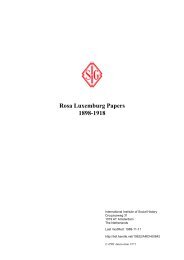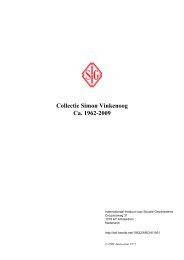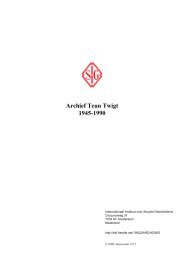Export to PDF - Search
Export to PDF - Search
Export to PDF - Search
You also want an ePaper? Increase the reach of your titles
YUMPU automatically turns print PDFs into web optimized ePapers that Google loves.
Archief Henk Sneevliet (1901) 1907-1942 (1945-1984, 2011)<br />
publication also includes an English translation of the relevant part of the Sneevliet inven<strong>to</strong>ry in 'Appendix<br />
Three: Contents of the Sneevliet Archive (1919-1924)'.<br />
Biographical data<br />
A biography of Sneevliet has been published in French by Fritjof Tichelman with the collaboration of Wim<br />
Bot and Tony Saich: Henk Sneevliet (Montreuil 1988). Biographical data on Sneevliet's Russian and Chinese<br />
period and his preceding career in Holland and the Dutch East Indies can be found in the introduction <strong>to</strong><br />
A.J. Saich's: The Origins of the First United Front in China: the role of Sneevliet (alias Maring). A very<br />
concise biographical sketch will have <strong>to</strong> suffice here. Hendricus Josephus Franciscus Marie Sneevliet was<br />
born in Rotterdam on 13 May 1883. In 1901, he started working as an employee for the Staatspoor railway<br />
company. From 1907 <strong>to</strong> 1910 he was a member of the city council of Zwolle, representing the Sociaal-<br />
Democratische Arbeiders Partij (SDAP, Social-Democratic Workers' Party). He became president of the<br />
Nederlandse Vereeniging van Spoor- en Tramwegpersoneel (NVSTP), a national union of rail and tramway<br />
personnel, in 1911, but resigned in 1912 after a conflict with the Nederlands Verbond van Vakverenigingen<br />
(NVV, Netherlands Federation of Trade Unions) <strong>to</strong> which the union was affiliated, over the seamen's strike.<br />
He left for the Dutch East Indies after securing a job as a journalist with Het Soerabajasch Handelsblad.<br />
From 1913 <strong>to</strong> 1917 he was secretary of the Handelsvereeniging (Trade Association) in Semarang. His<br />
activities in the labour movement included the founding in 1914 of the Indische Sociaal-Democratische<br />
Vereeniging (ISDV, Indian Social Democratic Association) and its presidency until 1918. In December 1918<br />
he was expelled for his political activities. In 1920 he was present at the Second Congress of the Comintern<br />
in Moscow as a representative of the ISDV. From 1921 <strong>to</strong> 1923 he represented the Comintern in the China.<br />
After his return <strong>to</strong> the Netherlands he became president of the syndicalist trade union Nationaal Arbeids<br />
Secretariaat (NAS, National Labour Secretariat) from 1924 <strong>to</strong> 1940. He resigned from the Communist<br />
Party of Holland in 1927. He founded the Revolutionair Socialistische Partij (RSP, Revolutionary Socialist<br />
Party ) in 1929 and was its president until 1935. After a merger the party changed its name <strong>to</strong> Revolutionair<br />
Socialistische Arbeiders Partij (RSAP, Revolutionary Socialist Workers' Party) of which Sneevliet became<br />
first secretary and later president until 1940. He was a Member of Parliament from 1933 <strong>to</strong> 1937. In the<br />
Second World War he headed a resistance group called Marx-Lenin-Luxemburg-front. He was tracked down<br />
and executed in 1942. Sneevliet was married four times. His first wife, Maartje Visser, whom he married on<br />
11 January 1906, left him for J.A.N. Knuttel .<br />
He was married <strong>to</strong> E.J. (Betsy) Brouwer from 22 July 1909 until their divorce on 26 September 1924. They<br />
had two sons, twins, born on 9 March 1911, nicknamed Pim (or Rido) and Pam (or Dikkop). Both committed<br />
suicide, Pim in 1932; Pam in 1937. Betsy died on 18 February 1966.<br />
From 1922 Sneevliet had a relationship with Sima L'vovna Žolkovskaja. They had a daughter also called<br />
Sima, born in Kremenchug on 18 September 1923. They were married on 21 December 1926, but Sima left<br />
Sneevliet in 1928 and married Jef Swart . With her daughter she returned <strong>to</strong> the Soviet Union <strong>to</strong> join Swart<br />
in 1934. In 1929 Sneevliet married W.H. (Mien) Draaijer. In the Second World War she was caught with<br />
Sneevliet and sent <strong>to</strong> the Ravensbrück concentration camp. She survived the war and died on 20 August<br />
1965.<br />
Noten:<br />
1. Max Perthus, Henk Sneevliet, revolutionair-socialist in Europa en Azië (Nijmegen 1976), pp. 32, 45-46,<br />
51, 59, 288, 300, 318, 325, 331-332, 346, 348, 385-386, 468;<br />
Sima Sneevliet met medewerking van Arno Langeler, Mijn jaren in stalinistisch Rusland ('s-Gravenhage<br />
1994), pp. 10-19;<br />
Ellen Santen, '"Trots alles". Mien Sneevliet-Draaijer 1894-1965', in Mies Bouhuys, Wilma Soederhuizen, et<br />
al. Vrouw in verzet - <strong>to</strong>en en nu (Amsterdam 1985), pp. 77-85, 95-101, 113;<br />
IISG, archief Henk Sneevliet, inv. nr. 740-746.<br />
2. Jaarverslag IISG 1937, p. 24.<br />
3. Jaarverslag IISG 1938, p. 23.<br />
4. Jaarverslag IISG 1953, p. 19.<br />
5. Jaarverslag IISG 1965, p. 6; zie ook Sal Santen, De nalatenschap van Henk Sneevliet (Amsterdam<br />
1995).<br />
Internationaal Instituut voor Sociale Geschiedenis 11

















